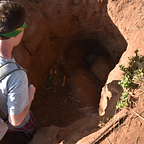Animals
It’s June 10th, 2018. In six days’ time, I will be in an enthusiastic throng of TTNG fans emerging from the woodwork to see the band play in Minneapolis. I’m looking forward to seeing the gentle UK group and their welcoming banter again, but frequently wonder why the other fans are there. TTNG is a staple of math-rock familiars, but how we all got here is a story that must have a wide variance.
Many parents invest in their child’s emergent tastes, happy to introduce soothing reminisces of individualism, good times, young love, or maybe even their own art to the blankest possible slate. To see someone else — especially your own offspring — take to your old favorites is a validating experience and a strange sort of covenant. A musical bequest from another time and place comes with the trust that new memories will accrete about a sonic artifact, and as the music’s history grows, the attached experiential diversity is unimportant to the trustees’ relationship (unless shared). Rather, attachments of all sorts grow into the community and commonality that are shared. It does not matter that my dad’s favorite memory of TTNG is reading a book on an airplane and looking out during as the clouds pass by silently if mine is sitting in a car with a new and exciting friend talking about our pasts until three in the morning. “Zebra” was playing in both these situations, and that shared bond can link experiences completely disparate.
I lied about my dad’s peaceful, music-box, airborne introspection. My dad doesn’t listen to TTNG, and Animals was released in 2008 (a bit late for Dad to be listening to in his formative years). My father and mother were into contemporary Christian music, ‘80s hair metal, and country. I don’t imagine that’s uncommon; most parents probably didn’t raise kids born in the ‘90s on American Football and the latest in ‘-post’ sub-genres. Maybe I’m missing some critical detail of parental music tastes elsewhere; regardless, it may be a fair assumption that fans of TTNG came across them by paths aside from the obvious formative ones: parents, radio, grandma’s record collection. Yet, those less-trodden paths to the music have led small crowds the world over to spend a night watching selections from Animals onstage.
I came across TTNG’s Animals sometime around junior year of high school. Like many groups of that musical epoch and beyond, my discovery is little more than a track on Spotify catching my ear or YouTube’s algorithmic suggestions being almost too good. There was no magical love-at-first-note watching TTNG open for a bigger band (I lived in Bismarck, ND anyway, let’s not kid ourselves). No friend handed me a CD or played “Panda” at a party (that sounds like a depressing party).
The real history comes with how TTNG introduced me to a starry new universe of tastefully complex bands. Their instrumentation is often chaotic rather than sleek or driving, but that meant I had found a band whose parts I could focus on one at a time, or ignore them all and be cleansed by sheets of sound. I could digest the creativity it takes to make up a drum groove when it’s hard to even find a downbeat or the temerity it takes to noodle as though in sprightly defiance of time altogether while remaining within a repeated structure. I could simply work as the album played quietly in the background, a soundtrack at a distance from white noise but nowhere close to distracting.
That description doesn’t do the band justice, though. If I wanted study music, I could listen to any number of derivative brown/white/green/rainbow noise albums or “24/7 lo-fi chill hip-hop radio: beats to study/relax to.” Animals became music for my life. I could think about rhythm and melody, listening for the guitar in “Chinchilla” or in moments of great sadness brood on the underrated melancholia of “Elk.” As a serial evangelist for my beloved “real music” in high school, I would pass on my CD rip of Animals to my friends in an attempt to inspire love for interweaving and interesting guitar and drum lines (as most other groups I knew under the banner of complexity at the time were closer to metal and further away from what even my friends were willing to stomach).
Animals further drove me away from the importance of lyricism, too. Stuart Smith isn’t a bad lyricist — in fact, there’s a good reason TTNG can hold their own in the canon of gentle post-emo. Many of the songs on Animals tell stories of broken love that seem almost too numerous for one human to bear. However, the indistinct crooning and relatively even volumes of the ensemble mix make vocals just another melody instrument, no less interesting than the guitar or bass lines. This meant I enjoyed every part of the music — I just couldn’t sing along very well in the car.
What Animals became is a beautiful, meandering soundtrack of diverse moods that played behind the writing of papers, quiet drives back from debate meets, and the exuberant sharing of musical taste and experience that was the prelude and first act of what I consider my first “real” relationship. As long as those memories exist, Animals will play behind them. Because of those times in the past, and maybe even because of this small tribute, perhaps your experience with TTNG started with a story involving me. Regardless of whether or not we do share the experience, what matters to me and the crowd on Friday is what we do share: pieces of the charming musical history of four guys from Oxford.
